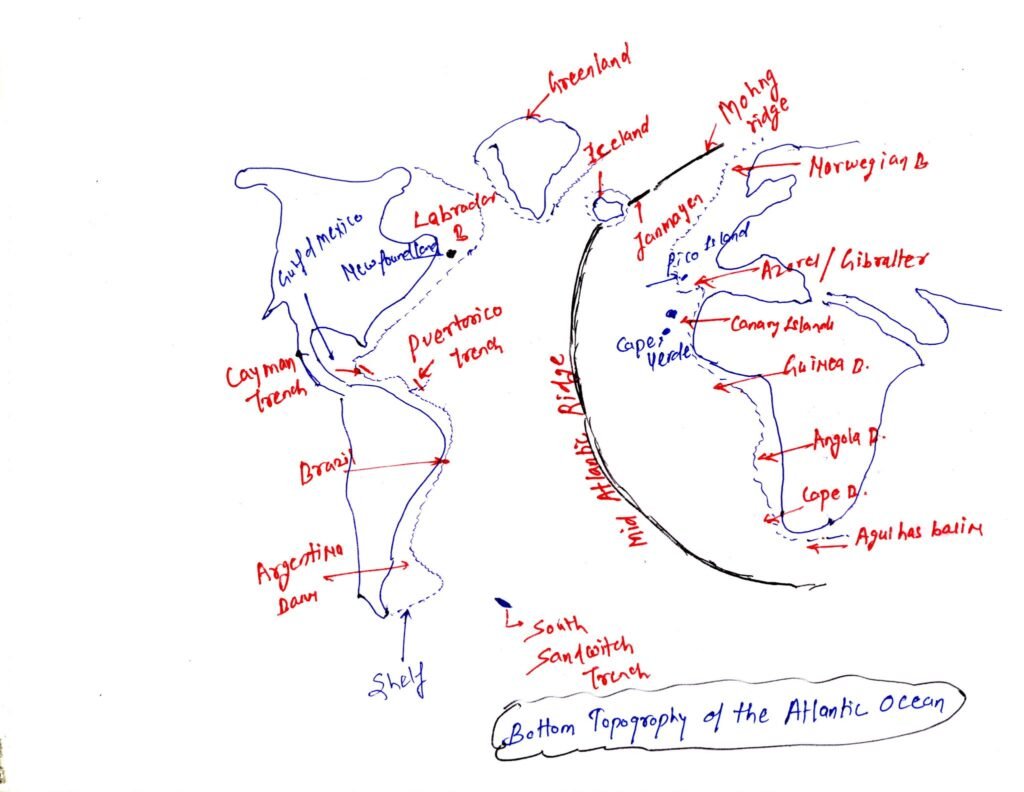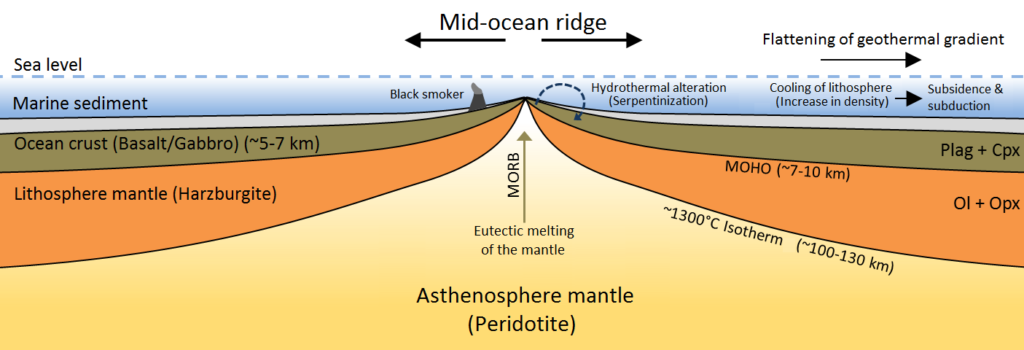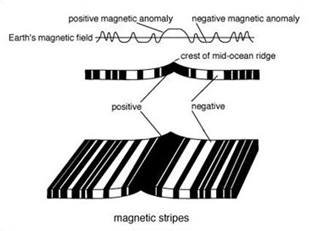This article is going to explain the bottom-relief features of the Atlantic Ocean. We will also describe the geography of the Atlantic Ocean and many more terms related to the Atlantic Ocean and its morphology.
bottom relief features of the Atlantic Ocean
The bottom relief features of the Atlantic Ocean include:
Mid-Atlantic Ridge:
A massive underwater mountain range runs down the center of the Atlantic Ocean, marking a divergent plate boundary where the Eurasian, North American, South American, African, and Antarctic Plates are moving away from each other.
Ocean Deeps:
Several deep ocean trenches exist, such as Nares Deep (6,000m), Puerto Rico Deep (8,385m), Hatteras Deep (5,445m), Columbia Deep (5,125m), Valdivia Deep (3,134 m), Tizard or Romanche Deep (9,370m), Buchanan Deep (3,063 m), and Moseley Deep (3,309 m).
Marginal Seas:
Significant marginal seas include the Mediterranean Sea, the Caribbean Sea, and the Gulf of Mexico.
Ocean Basins:
The Atlantic Ocean is divided into two major basins, the East and West Atlantic Basins, by the Mid-Atlantic Ridge.
Abyssal Plains:
Flat, sediment-covered regions of the deep ocean floor that lie at depths of 3,000 to 6,000 meters.
Seamounts:
mountains or volcanoes that rise from the seafloor but do not reach the ocean surface.
Trenches:
Deep, narrow, and extremely deep depressions in the seafloor, such as the Puerto Rico Trench and Romanche Trench.
Rift Valleys:
Associated with tectonic plate movements and marked by geological features like faults and ridges.
These features are important for understanding the ocean’s geological history, marine life, and ocean circulation patterns. The Atlantic Ocean is the second largest ocean after the Pacific Ocean and covers approximately 20% of Earth’s surface.

What is the mid-Atlantic ridge, and how does it affect the bottom relief of the Atlantic Ocean?
The Mid-Atlantic Ridge is a submarine mountain range that stretches along the floor of the Atlantic Ocean, separating the North American Plate from the Eurasian Plate in the North Atlantic and the South American Plate from the African Plate in the South Atlantic. It is part of the longest mountain range in the world and is a divergent plate boundary where a new ocean floor is created as the Earth’s tectonic plates spread apart.
The ridge is characterized by an axial rift valley, which is about 50 to 75 miles (80 to 120 km) wide and contains the zone of seafloor spreading. The Mid-Atlantic Ridge is also the site of volcanic activity and earthquakes, and it is responsible for the widening of the Atlantic Basin at an estimated rate of 1 to 10 cm (0.5 to 4 inches) per year.
The Mid-Atlantic Ridge affects the bottom relief of the Atlantic Ocean by creating a central rift valley that separates the ocean into two major basins, the East and West Atlantic Basins. The ridge also influences the distribution of ocean depths, seamounts, and trenches, as well as the location of volcanic islands such as Iceland, the Azores, and St. Helena.
The ridge’s formation and activity have played a significant role in the breakup of the supercontinent Pangaea, which began some 180 million years ago.

How does the mid-Atlantic ridge affect the magnetic field of the Earth?
The Mid-Atlantic Ridge affects the Earth’s magnetic field through the process of seafloor spreading and the formation of basaltic lava. As the Earth’s tectonic plates move apart at the ridge, molten rock rises to the surface, cools, and forms basaltic lava. This lava becomes permanently magnetized in the direction of the Earth’s magnetic field at the time of the eruption.
As the plates continue to move apart, a new ocean lithosphere is formed, and the magnetic stripes recorded in the basaltic lava are aligned in a series of alternating magnetic polarity stripes.
These stripes provide a record of the Earth’s magnetic field reversals over time, which have occurred hundreds of times during the past several hundred million years.
The magnetic properties of the erupted basalt have been used to map the magnetic stripes on the ocean floor, revealing the rate at which the Atlantic Ocean is opening by seafloor spreading from the Mid-Atlantic Ridge.
What is the significance of the mid-Atlantic ridge in recording the direction of the Earth’s magnetic field?

The Mid-Atlantic Ridge is significant in recording the direction of the Earth’s magnetic field because the basaltic lava that forms at the ridge becomes permanently magnetized in the direction of the Earth’s magnetic field at the time of eruption. As the Earth’s tectonic plates move apart at the ridge, a new ocean lithosphere is formed, and the magnetic stripes recorded in the basaltic lava are aligned in a series of alternating magnetic polarity stripes.
These stripes provide a record of the Earth’s magnetic field reversals over time, which have occurred hundreds of times during the past several hundred million years. The magnetic properties of the erupted basalt have been used to map the magnetic stripes on the ocean floor, revealing the rate at which the Atlantic Ocean is opening by seafloor spreading from the Mid-Atlantic Ridge.
Therefore, the Mid-Atlantic Ridge is an important site for studying the history of the Earth’s magnetic field and its changes over time.
What is the relationship between the mid-Atlantic ridge and the earth’s magnetic field?
The Mid-Atlantic Ridge and the Earth’s magnetic field are related because the basaltic lava that forms at the ridge becomes permanently magnetized in the direction of the Earth’s magnetic field at the time of eruption.
As the Earth’s tectonic plates move apart at the ridge, a new ocean lithosphere is formed, and the magnetic stripes recorded in the basaltic lava are aligned in a series of alternating magnetic polarity stripes.
These stripes provide a record of the Earth’s magnetic field reversals over time, which have occurred hundreds of times during the past several hundred million years.
The magnetic properties of the erupted basalt have been used to map the magnetic stripes on the ocean floor, revealing the rate at which the Atlantic Ocean is opening by seafloor spreading from the Mid-Atlantic Ridge.
Therefore, the Mid-Atlantic Ridge is an important site for studying the history of the Earth’s magnetic field and its changes over time.
geography of the Atlantic Ocean?
The Atlantic Ocean is the second-largest ocean in the world, covering approximately 20% of the Earth’s surface and separating the continents of Europe and Africa to the east from the Americas to the west. It is bordered by the Arctic Ocean to the north, the Southern Ocean to the south, the Indian Ocean to the southeast, and the Pacific Ocean to the southwest.
The Atlantic Ocean is divided into two basins, the North Atlantic and the South Atlantic, by the Equator. The ocean has an S-shaped basin extending longitudinally between Europe and Africa to the east and the Americas to the west.
The Atlantic Ocean has irregular coasts indented by numerous bays, gulfs, and seas, including the Baltic Sea, Black Sea, Caribbean Sea, Gulf of Mexico, Labrador Sea, Mediterranean Sea, North Sea, Norwegian Sea, almost all of the Scotia Sea, and other tributary water bodies.
The Atlantic Ocean is also home to several significant features, including the Mid-Atlantic Ridge, which is an immense median mountain range extending throughout the length of the Atlantic, and the Puerto Rico Trench, which is the lowest point in the Atlantic Ocean.
The ocean is also known for its hurricanes, which mostly form between June and November each year.


